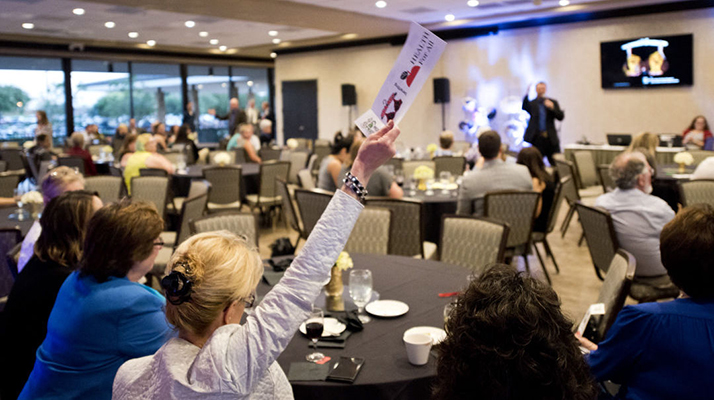Donation Appraisal with Art of Estates
Appraisal Firm, Art of Estates’, was founded upon IRS Estate Tax appraisals for clients who have been blessed enough to have an estate that would warrant or necessitate our services. Those values use Fair Market Value as an approach to value on their personal property. Fair Market Value is also used in the donation and non-cash charitable contribution appraisal process for property donated or given to a not-for-profit or non-profit organization or institution. While the two definitions for the IRS have a slight difference to the definition for these two purposes, the approach is very much the same. Where Art of Estates comes into play most commonly, is with fine art, antiques, decorative art, and American Indian (Native) pottery being donated to a museum or historical society.

Fair Market Value for Non-Cash Charitable Donation
IRS / Internal Revenue Regulation Section § 1.170A-1(c)(2)
Fair Market Value is the price at which property would change hands between a willing buyer and a willing seller, neither being under the compulsion to buy or sell and both having reasonable knowledge of relevant facts. The 8283 Form that the appraiser you hire signs along with the donor was updated in November of 2022.

Qualified Appraisal & Appraiser
Internal Revenue Code Section 170(f)(11)(E)(ii)
The term “qualified appraisal”, with respect to personal property, is an appraisal that is treated under regulations and other guidance provided by the Secretary, is conducted by a qualified appraiser in accordance with accepted appraisal standards in any regards to regulations, USPAP, or other guidance prescribed under the Federal sub clause.
The appraiser has earned an appraisal designation from a recognized professional appraiser organization or has otherwise met minimum education and experience requirements set forth in regulations prescribed by the Secretary, regularly performs appraisals for which the individual receives compensation and meets such other requirements as may be prescribed by the Secretary in regulations or other guidance.
Specific appraisals an individual shall not be treated as a qualified appraiser with respect to any specific appraisal unless the individual demonstrates verifiable education and experience in valuing the type of property subject to the appraisal, and the individual has not been prohibited from practicing before the IRS by the Secretary under section 330 (c) of title 31, United States Code, at any time during the 3-year period ending on the date of the appraisal.
Art of Estates Appraisers
As an appraiser with Art of Estates, no appraiser that has been prohibited from practicing before the IRS will ever be listed on our website. Nor will any appraiser that has been prohibited from working with the IRS be allowed to continue working with Art of Estates. All appraisers listed on our website have completed a minimum of core courses and has received training with one, or several, of the top 4 professional appraiser organizations as well as training and experience internally with Art of Estates. Continuing education and USPAP completion is also part of our expectations in accordance with our professional appraisal associations and affiliations.
In an effort to produce the highest quality of appraisals in our industry, it is common for our team to internally review appraisals before they are transmitted to our clients to ensure high levels of accuracy, clarity, and value conclusions. The Appraisal Firm has a commitment to excellence and reliability in producing unbiased and market driven valuation services.
Art of Estates completes reports on a regular basis for our clients that donate non-cash charitable contributions to museums, universities, historical societies, educational, and learning organizations and related institutions.
Donations
The public’s must common point of contact with the non-cash charitable contribution process is when they donate furniture, residential contents or other types of personal property to a Goodwill thrift store. The folks outside unloading your items often give you a slip or certificate for you to fill out. Many become lost or never used because they believe the value wasn’t worth the slip or possibly even the trip to the location. Generally speaking, the max amount that can be written off with this process without an appraisal, and an appraiser signing an 8283 Form is set at $500 yearly. Therefore, if the property isn’t valuable enough to offset the cost of the appraisal and the percentage rate benefited from the $500 you will be able to credit towards your taxes, then getting an appraisal would be cost prohibitive.

Generally, you may deduct charitable contributions of personal property or a collection made to qualified organizations if you itemize your deductions in an appraisal, deducting up to 50 percent of your adjusted gross income, but 20 percent and 30 percent limitations apply in some cases. When donating to an organization, we recommend to our clients to place constraints on the organizations ability to sell the appraised property under 3 years’ time, because not doing so may complicate your deduction at a later date. An organization must file Form 8282 if, within 3 years of receiving property for which it was required to sign a Form 8283, it sells, exchanges, consumes, or otherwise disposes of the property. The organization must also send you a copy of the form. Form 8282 must be filed within 125 days after the disposition. A copy of Form 8282 must be given to the previous donor. If the organization fails to file the required information return, penalties may apply. Vehicle donations have their own unique set of rules and guidelines.
Charity Auctions
If you are donating personal property (art, clothing, antiquities, etc.) to an organization, it is usually best to use the resulted value in the auction as your tax basis. However, in most cases where we have been contacted about a very valuable item that may not result in a comparable sale conclusion of Fair Market Value at a charity fundraiser. It is often best to have it sold under our VMALS (Value-Maximizing Auction Location Service) process, then use the monetary gains to make a cash donation to the organization to reduce potential gains for both the donor and the donee. This process can often be more rewarding to the donor and the donee, but also be more reliable, specific in tax filings, and quantitative. Here is what the IRS has to say about “Charity Auctions”:
Donors who purchase items at a charity auction may claim a charitable contribution deduction for the excess of the purchase price paid for an item over its fair market value. The donor must be able to show, however, that he or she knew that the value of the item was less than the amount paid. For example, a charity may publish a catalog, given to each person who attends an auction, providing a good faith estimate of items that will be available for bidding. Assuming the donor has no reason to doubt the accuracy of the published estimate, if he or she pays more than the published value, the difference between the amount paid and the published value may constitute a charitable contribution deduction.
In addition, donors who provide goods for charities to sell at an auction often ask the charity if the donor is entitled to claim a fair market value charitable deduction for a contribution of appreciated property to the charity that will later be sold. Under these circumstances, the law limits a donor’s charitable deduction to the donor’s tax basis in the contributed property and does not permit the donor to claim a fair market value charitable deduction for the contribution. Specifically, the Treasury Regulations under section 170 provide that if a donor contributes tangible personal property to a charity that is put to an unrelated use, the donor’s contribution is limited to the donor’s tax basis in the contributed property. The term unrelated use means a use that is unrelated to the charity’s exempt purposes or function, or, in the case of a governmental unit, a use of the contributed property for other than exclusively public purposes. The sale of an item is considered unrelated, even if the sale raises money for the charity to use in its programs. – updated by IRS on January 21, 2022
When providing a non-cash charitable donation, it is best to make sure the organization has an appropriate a verifiable related use. A good example of related use is an oil painting by a notable artist being donated to an art museum. A good example of an unrelated use would be an antique oil derrick being donated to a doll museum.
If you are purchasing personal property (memorabilia, collectibles, fine art, etc) from an organization holding a charity auction, you may be eligible to claim a charitable contribution deduction for the excess of the purchase price paid for an item over its Fair Market Value. Art of Estates can review the pre-auction estimate, for determination of accuracy and validity to see if there is spread worth filing in your taxes. If there is credible terms to the claim, Art of Estates could provide an Fair Market Value based appraisal based on unbiased market examples.

More Information & Definition of Support
Private Foundations Defined — IRC 509(a)(1) and 170(b)(1)(A)(vi) Exclusion
Blockage
If you have a large amount of one type of property or of one artist, an appraiser may need to apply blockage to the appraisal approach. Generally speaking, blockage is formula used to determine how long it will take for the property to be absorbed into the market or the market absorption rate considering and a host of other market related factors. While the information below pertains to IRS estate taxes, it also needs to be considered and has been used for other areas of the appraisal field. It has been used in Insurance Claims, Divorce Cases, IRS Estate Tax Disputes, Bankruptcies, Charitable Contributions, and a host of other litigious cases. Early research may need to be investigated to determine costs associated with this process and the viability of the project.
ESTATE OF DAVID SMITH v. COMMISSIONER OF THE INTERNAL REVENUE SERVICE 57 TCM 650 (1972)
- Court Opinion: “simultaneous availability of an extremely large number of items of the same general category is a significant circumstance which should be taken into account.”
- Cited from Stephanie J. Willbanks’ book, Federal Taxation of Wealth Transfers: Cases and Problems
ESTATE OF GEORGIA T. O’KEEFFE v. COMMISSIONER OF THE INTERNAL REVENUE SERVICE 63 TCM 2699 (1992‐210)
- Court Opinion: “nothing in the opinion, however, explains the conclusion of value by application of a particular percentage to the total.”
- Cited from Stephanie J. Willbanks’ book, Federal Taxation of Wealth Transfers: Cases and Problems
Art of Estates has previously performed the blockage process in an uncontested, formal, USPAP compliant, accredited, and certified appraisal report for court proceedings.

Charitable Contribution Terms to Know when Making a Donation
Adjusted Gross Income: The level of income on which you pay federal income tax, before itemized deductions and personal exemptions. This amount is used as a starting point for computing limitations on certain deductions.
Religious organization: A recognized entity that exists to further religious or related objectives. Additional documentation may be required from these types of organizations before Vanguard Charitable can issue them grants.
Tax-Exempt Organization: A nonprofit (not for profit) organization that does not have to pay state or federal income taxes. Any organization (other than a church) seeking recognition of its status as tax-exempt must apply to the IRS and may have to fulfill additional state applications or registration requirements. Charities may also be exempt from sales and local property taxes.
Unrestricted Funds: Funds that are not specifically targeted to particular uses by the donor, or for which restrictions have expired or been removed.
Form 8282: IRS Form to be completed by charities that sell, exchange, or dispose of donated property within three years of receipt.
Form 8283: IRS form for noncash charitable contributions, filed by the taxpayer for any tax year in which you claimed a total deduction of more than $500 for all contributed property, including publicly traded securities.
501(c)(3): Section of the Internal Revenue Code that designates organizations as charitable and tax-exempt. Organizations qualifying under this section include religious, educational, charitable, amateur athletic, scientific, and literary groups; and organizations involved in the prevention of cruelty to children or animals.
IRS Federal Non-Cash Charitable Tax Forms & Publications to Know when Making a Donation
Instructions for 8283 – appraisal thresholds & requirements
Form 8283 – qualified appraiser signature required along with appraisal
Instructions for Form 1041 – charitable trust & deduction clarification
Form 1041 – income Tax return for Estate & Trust w/Schedule A charitable deduction section
Form 8282 – donee information for returns (sale, exchange, or other disposition of donated property)
Publication 526 – qualified organizations & overall guidelines of pros/cons
Publication 561 – determining value of donated property
Schedule A – itemized Deductions
For tax or legal advice, please call a credentialed accountant or a professional attorney since the information on this website is not and should not be considered tax or legal advice and is not a substitute or supplementation for tax or legal advice.

